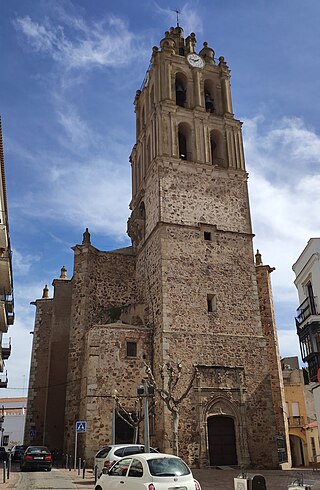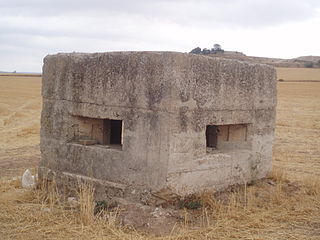
Robert Capa was a Hungarian–American war photographer and photojournalist. He is considered by some to be the greatest combat and adventure photographer in history.

The Sierra Morena is one of the main systems of mountain ranges in Spain. It stretches for 450 kilometres from east to west across the south of the Iberian Peninsula, forming the southern border of the Meseta Central plateau and providing the watershed between the valleys of the Guadiana to the north and the west, and the Guadalquivir to the south.

Gerta Pohorylle, known professionally as Gerda Taro, was a German war photographer active during the Spanish Civil War. She is regarded as the first woman photojournalist to have died while covering the frontline in a war.
The Battle of Mérida saw Republican militia twice fail to halt the Spanish Army of Africa near the historic town of Mérida early in the Spanish Civil War.
The Battle of Málaga was the culmination of an offensive in early 1937 by the combined Nationalist and Italian forces, with air and naval support from Nazi Germany, to eliminate Republican control of the province of Málaga during the Spanish Civil War. The participation of Moroccan regulars and Italian tanks from the recently arrived Corpo Truppe Volontarie resulted in a complete rout of the Spanish Republican Army and the capitulation of Málaga in less than a week.

The siege of Madrid was a two-and-a-half-year siege of the Republican-controlled Spanish capital city of Madrid by the Nationalist armies, under General Francisco Franco, during the Spanish Civil War (1936–1939). The city, besieged from October 1936, fell to the Nationalist armies on 28 March 1939. The Battle of Madrid in November 1936 saw the most intense fighting in and around the city when the Nationalists made their most determined attempt to take the Republican capital.
The Battle of Talavera de la Reina was fought on 3 September 1936 in the Spanish Civil War. The Republicans, attempting to bar the road to Madrid at Talavera de la Reina, were defeated by the professional army of the Nationalists, with heavy casualties on both sides.

The Battle of Santander was fought in the War in the North campaign of the Spanish Civil War during the summer of 1937. Santander's fall on 26 August assured the Nationalist conquest of the province of Santander, now Cantabria. The battle devastated the Republic's "Army of the North"; 60,000 soldiers were captured by the Nationalists.

The War in the North was the campaign of the Spanish Civil War in which the Nationalist forces defeated and occupied the parts of northern Spain that had remained loyal to the Republican government.

The Falling Soldier is a black and white photograph by Robert Capa, claimed to have been taken on Saturday, September 5, 1936. It was said to depict the death of a Republican Iberian Federation of Libertarian Youth (FIJL) soldier, during the Battle of Cerro Muriano in the Spanish Civil War. The soldier in the photograph was later claimed to be the anarchist militiaman Federico Borrell García.

Federico Borrell García was a Spanish Republican and anarchist militiaman during the Spanish Civil War, commonly thought to be the subject in the famous Robert Capa photo The Falling Soldier.

The Battle of Guadarrama was the first battle in the Spanish Civil War involving troops loyal to the Second Spanish Republic in the Guadarrama Range. The battle took place in the last week of July and in early August 1936. The Nationalist side sent by General Mola was attempting to cross the mountain passes of the Sierra de Guadarrama and reach Madrid by the North, but the Republican side, made up of militiamen and troops disbanded by the government left Madrid to stop the Nationalists. The Republican side was successful and the Nationalist troops did not manage to cross the mountain passes.

The Battle of Almendralejo was a battle and massacre in Almendralejo, Spain, in August 1936, during the first stages of the Spanish Civil War.
The Córdoba offensive was a failed Republican offensive against the Nationalist held city of Cordoba. It took place from 19 to 22 August 1936 during the Spanish Civil War.
The siege of Santuario de Nuestra Señora de la Cabeza took place from 14 September 1936 to 1 May 1937 in Andújar, Jaén, during the Spanish Civil War. The Republican army surrounded around 1,200 rebel civil guards and falangists who supported the Nationalists and forced them to surrender after a protracted offensive.
The Battle of Lopera took place between 27 and 29 December 1936 during the Spanish Civil War. This battle took place during the Nationalist's Aceituna offensive. On 27 December, the XIV International Brigade launched an attack in order to occupy the Nationalist-held town of Lopera, but the attack failed after two days and the Brigade suffered appalling casualties.

The Battle of Segre is the collective name of a series of battles that took place along the Segre River between 4 April 1938 and 3 January 1939 during the Spanish Civil War, after the Nationalist Faction had broken the lines of the Spanish Republican Army in the Aragon Offensive.
The Aceituna Campaign took place during the Spanish Civil War in 1936. In December 1936, the Nationalists launched an offensive in order to occupy the town of Andújar. The Nationalists occupied 2,600 square kilometres (1,000 sq mi) and defeated the Republican Army at Lopera, but failed to occupy Andújar.

The Cartagena uprising took place 4–7 March 1939 during the Spanish Civil War. The troop transport SS Castillo de Olite was sunk during the revolt.
The following events occurred in September 1936:











